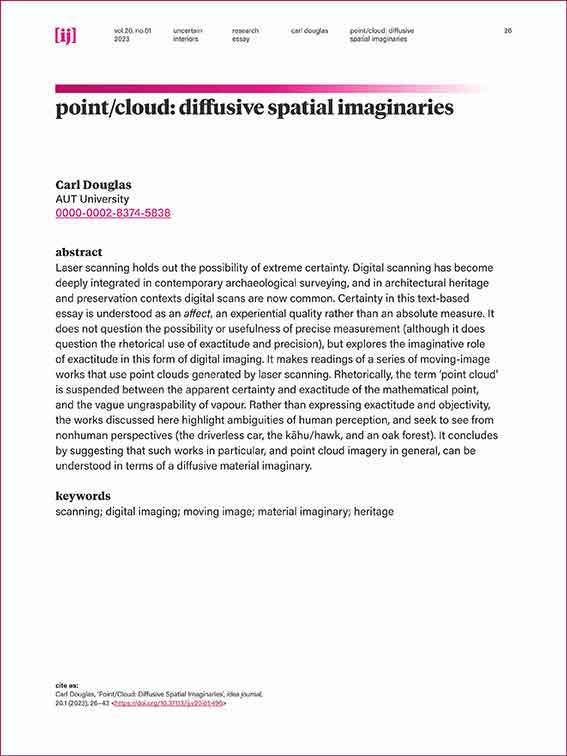Point/Cloud Diffusive Spatial Imaginaries
Main Article Content
Abstract
Laser scanning holds out the possibility of extreme certainty. Digital scanning has become deeply integrated in contemporary archaeological surveying, and in architectural heritage and preservation contexts digital scans are now common. Certainty in this text-based essay is understood as an affect, an experiential quality rather than an absolute measure. It does not question the possibility or usefulness of precise measurement (although it does question the rhetorical use of exactitude and precision), but explores the imaginative role of exactitude in this form of digital imaging. It makes readings of a series of moving-image works that use point clouds generated by laser scanning. Rhetorically, the term ‘point cloud’ is suspended between the apparent certainty and exactitude of the mathematical point, and the vague ungraspability of vapour. Rather than expressing exactitude and objectivity, the works discussed here highlight ambiguities of human perception, and seek to see from nonhuman perspectives (the driverless car, the kāhu/hawk, and an oak forest). It concludes by suggesting that such works in particular, and point cloud imagery in general, can be understood in terms of a diffusive material imaginary.
Article Details
Author/s and or their institutions retain copyright ownership over works submitted to Idea Journal, and provide the Interior Design / Interior Architecture Educators Association with a non–exclusive license to use the work for the purposes listed below:
- Make available/publish electronically on the Idea Journal website
- Publish as part of Idea Journal's online open access publications
- Store in electronic databases, on websites and CDs/DVDs, which comprise of post-publication articles to be used for publishing by the Interior Design / Interior Architecture Educators Association.
Reproduction is prohibited without written permission of the publisher, the author/s or their nominated university. The work submitted for review should not have been published or be in the process of being reviewed by another publisher. Authors should ensure that any images used in their essays have copyright clearance.

